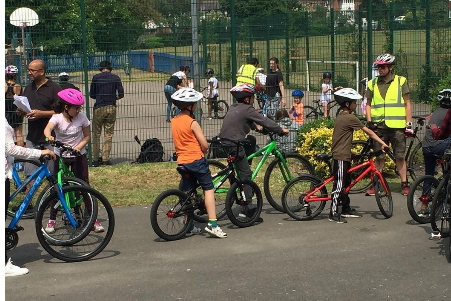
This project offers walking and cycling activities that are open to everyone, regardless of finances, age, background or ability. The scheme supports families and participants of all ages to come together to experience the physical and mental wellbeing effects of these activities. Training and practice sessions with a qualified cycle or walk leader are provided to ensure that different age groups feel confident participating.
The project also runs weekly walks and cycle rides, guiding safely through local parks and open spaces, to ensure participants get the opportunity to socialise and benefit from fresh air.
The project also motivates participants to lead a healthier lifestyle by offering them access to health equipment such as body weight scales, heart monitoring devices and blood pressure monitors. These devices can help older participants to track their health goals, visualise and understand data and get tailored insights into promoting a healthier lifestyle. As these are non-medical devices, these can be facilitated through the project/activity leader, or through any volunteers. Health equipment can be used at a community centre or at the location where the walks and cycles originate or end from.
A popular addition for similar projects has been the provision of a foot massager. This tool can give immediate relief for those participants who need their muscles stimulating after walking, improving circulation and reducing stiffness. This may be particularly beneficial for older participants.
Target audience and engagement
- Families and those within a disadvantaged demographic group
- Promote your project by hosting or attending events and using publicity materials, such as leaflets or posters
- Use existing networks with community groups, relationships with schools, or seek out specialist and charity organisations to help you to raise awareness of your activities
- Engagement can also be through social media, with specific targeting to potential user groups
Reach
- Large (130 - 150 participants)
- Geographically- anywhere there are green, open spaces. Example spaces include, parks and woodlands, estates and managed gardens, bike lanes and walking footpaths
Equipment needed
- Bikes - Participants own or bought bikes
- Bike maintenance equipment – Bike pump, spare tyres etc
- Reusable water bottles
- Foot massager
- Blood pressure monitor
- Physical activity belts
- BMI weighing scales
- Space for meeting (either hired, owned or public space)
Resources needed
- Project Leader:
-Oversee the project, ensure the participants feel safe and enjoy their experience
-Ensure all funding criteria and documentation is met
-Run risk assessment for safeguarding, injuries, and to identify any other concerns which may affect project delivery
-Gather feedback from participants
-The project lead should have the requisite level of DBS, understand health and safety needs and preferably be first aid trained - Project volunteers:
-Help answer queries
-Contribute to overseeing activities and resolve any equipment issues
-Run or support the running of the activities - Storage Space:
-You will need somewhere to store equipment. This could be at a community centre, in an existing office, or perhaps another local business that has a storage facility - Publicity:
-Flyers and posters for publicity of the sessions - Refreshments:
-Tea, coffee and snacks at every session, this will lighten the mood, offer a chance for participants to come together and socialise, and offers an incentive for people to come
Estimated project costs
- Bikes of various sizes £1,050
- Activity belts £620
- Portable water dispenser £145
- Foot massager £115
- BMI smart weighing scales £120
- Blood pressure monitor £130
- Public liability insurance (if needed) £170
- Qualified walk/cycle leader £700
- Design and printing of publicity materials £400
- DBS checks (if needed) £200
- Cycling helmets £90
- Bike spares and repairs £400
- Management and administrative costs (could be costed as in-kind) £600 - £1,000
Top tips/key learnings
- Ensure that you engage with and listen to every participant; they will provide a valuable insight into how you can improve your project in the future.
- Older residents are keen to participate, and it is important to listen to their needs
- Revise risk assessments of the activities at intermittent points to ensure activities run more smoothly
- Ensure that there are alternative plans for each session to cope with unforeseen circumstances such as changes in weather
- Take advantage of the training programme that is offered by Walking and Cycling Grants London
Maximising local contacts
- Try to make contact and build working relationships with charities/organisations that specialise in your chosen target audience. This will allow for referrals to be made to you and increase your overall participant reach
- Engage with your local council - they may be able to lend you equipment, help market the project help secure a local space for meetings, or other support
This project idea was provided by The Hope of Childs Hill - Twitter - Instagram
If you decide to run your own version of this project in your community, please email us at wcgl@groundwork.org.uk. We love to hear that we are inspiring people to walk and cycle.